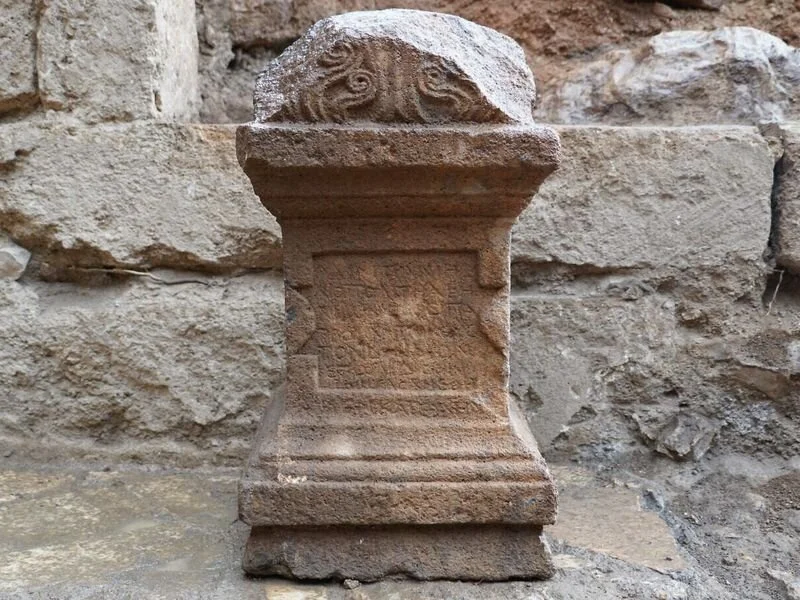Christians in what is now northern Israel may have repurposed the basalt structure as a deliberate affront to pagan worshippers
This excavation is now focusing on figuring out how this pagan altar came to be part of the church wall and what the inscription on it means.
The altar's inscription suggests pilgrims traveled great distances to reach the religious site. (Jonathan Orlin / Israel Nature and Parks Authority)
An Israeli team of researchers excavating a Byzantine church in the Banyas Nature Reserve in Northern Israel believed to be from about 400 AD recently discovered a Roman-era temple to the Greek god, Pan, beneath the church, and made another find that sheds further light on the way that the lives of the later Christians were intertwined with those who worshiped the earlier faiths: a 2nd- or 3rd-century AD altar with a Greek inscription found in the walls of the church.
The church, which is one of the oldest ever found, was important to early Christians, according to Prof. Adi Erlich of the Zinman Institute of Archaeology, University of Haifa, who is leading the excavation of the site with Prof. Ron Lavi. “This site would have had tremendous significance for Christians of the Byzantine era, who believed that this is where Jesus told Peter, ‘I give you the keys to the kingdom of Heaven,’” said Erlich.
Pan having sex with a goat, statue from Villa of the Papyri, Herculaneum.
In ancient Greek religion and mythology, Pan is the god of the wild, shepherds and flocks, nature of mountain wilds, rustic music and impromptus, and companion of the nymphs. He has the hindquarters, legs, and horns of a goat, in the same manner as a faun or satyr. With his homeland in rustic Arcadia, he is also recognized as the god of fields, groves, wooded glens and often affiliated with sex; because of this, Pan is connected to fertility and the season of spring. The ancient Greeks also considered Pan to be the god of theatrical criticism. The word panic ultimately derives from the god's name.
This excavation, which is supported and was initiated by the Nature and Parks Authority, is now focusing on figuring out how this pagan altar came to be part of the church wall and what the inscription means. The inscription is being studied by Dr. Avner Ecker of Bar-Ilan University. The inscription, which is in Greek, reads, “Atheneon son of Sosipatros of Antioch is dedicating the altar to the god Pan Heliopolitanus.
He built the altar using his own personal money in fulfillment of a vow he made." Two main things are interesting about this inscription – the combination of Pan with Heliopolitanus, a name normally associated with Zeus, and the origin of the donator from faraway Antioch, some 400 km to the north, located on what is now the on the Turkey-Syria border. “It seems that this cult place was visited by pilgrims coming from afar,” said Erlich.
The altar to the Greek god Pan is seen at a Byzantine church in Banyas.
(photo credit: OFER SHINAR)
The Banyas excavation is in a unique location that features a cave, cliff and springs, alongside a terrace formed from the partial collapse of the cliff. The temple was built not long before the beginning of the Christian era.
The Banias waterfalls were associated with Pan long before the temple's construction around 20 B.C. (Chadica via Flickr under CC BY 2.0)
The discovery of this altar and its inscription raises as many questions for the team researching the site as it answers. The altar was found lying horizontally and it was not until the stone had been thoroughly cleaned that the inscription became visible. Erlich noted that the stone is basalt, and not the local limestone, which is generally found in the area but said that the basalt tends to preserve inscriptions even better than limestone. Why this worshiper chose basalt is one of the many questions the team is investigating in this site that has yielded so many fascinating finds.












